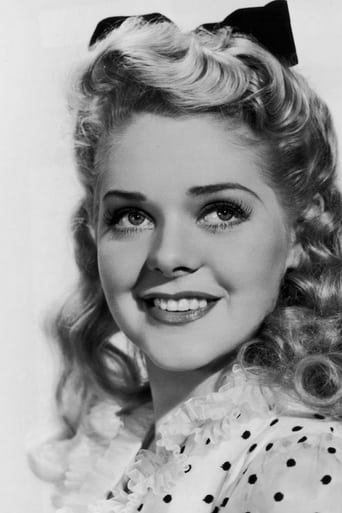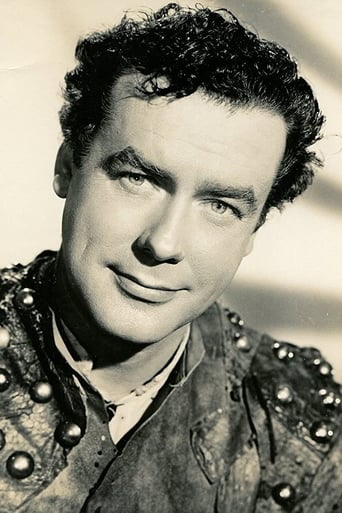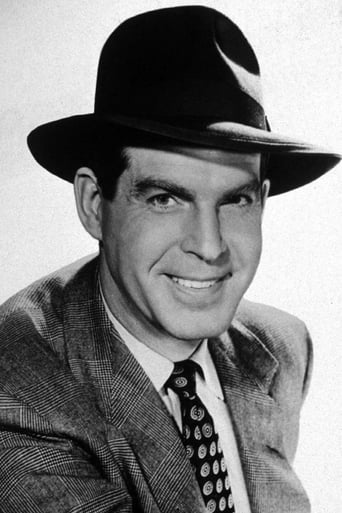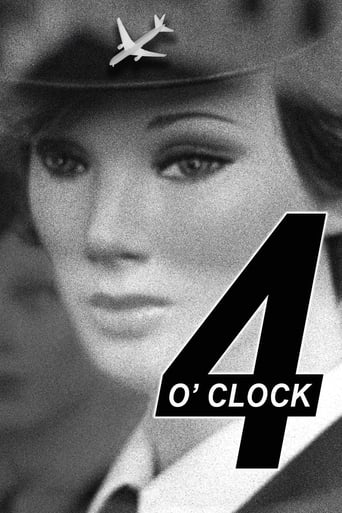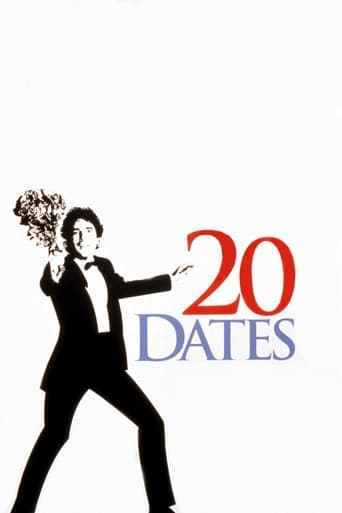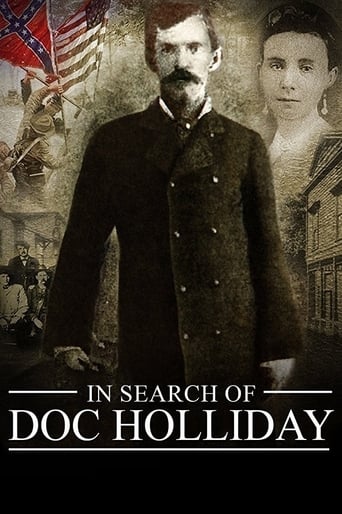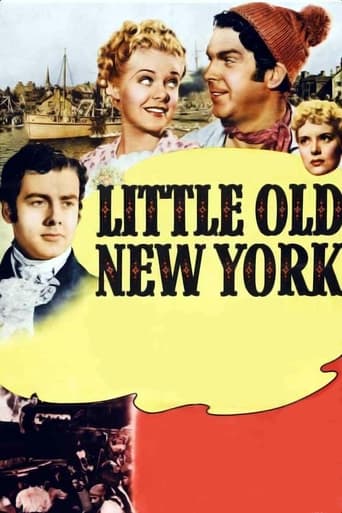
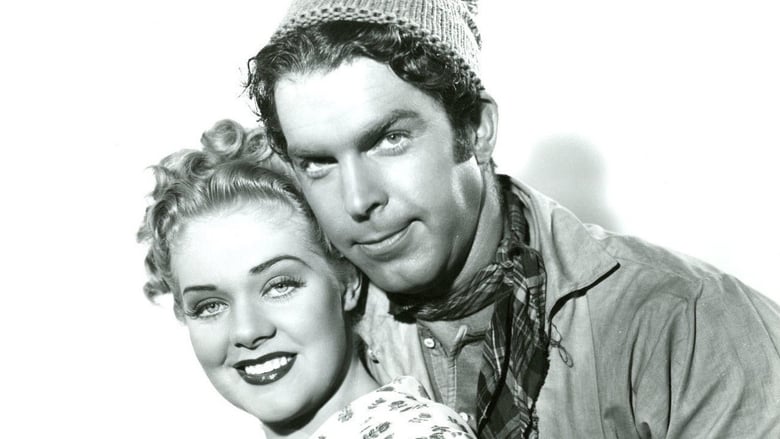
Little Old New York (1940)
Inventor Robert Fulton receives support from a tavern owner and a shipyard worker to help realize his dream of a high-powered steamboat.
Watch Trailer
Cast


Similar titles
Reviews
Very very predictable, including the post credit scene !!!
How sad is this?
A Disappointing Continuation
The film makes a home in your brain and the only cure is to see it again.
Charming screenplay and excellent choice of actors. A hidden gem! A mix of historical facts and persons and purely fictional events and persons, as was the norm for this period of Hollywood biopics. Thus, Robert Livingston and Nikolas Roosevelt are included among the financiers or politically influential in getting the first steamboat on the Hudson built. Harriet Livingston: niece of Robert Livingston, is also included as Fulton's(Richard Greene)fiancé(and wife, in real life). On the other hand, Charles Browne(Fred MacMurray): the man who organized the building of the hull for Fulton's boat, is fictional(I assume). Andy Devine's comical 'Commodore' character runs ferryboats out of Manhattan, having browbeaten his competition into giving up. Alice Faye's role as Pat O'Day, who runs a dockside tavern and accommodates Fulton in her rooms upstairs, is also fictional, I assume. Ward Bond plays Ragen: the chief organizer of opposition to building a steamboat, on grounds that sailors will lose their jobs if steamboats replace sailing ships. For those who like to see an occasional brawl, Fulton and Ragen tangle over Fulton's small model of his boat. Later, there is a big brawl after Fulton's model is destroyed...For those who like some comedy, there's plenty of light humor, mostly involving Alice Faye or Andy Devine, or Noah(Ben Carter, who was Alice's African American assistant. Although Alice helped Fulton in various ways and hoped to marry him, when they first met, Alice threw a wet towel at MacMurray , who ducked, it hitting Fulton in the face. Later, Alice bursts into a formal dinner hosted by Livingston with Fulton's boat model, thinking he forgot it, to everyone's amusement or embarrassment...For music, there is a group sing of the Mack Gordon-composition "Who is the Beau of the Bell of New York". There's plenty of drama at the personal level as well as relating to the steamboat. Ward organizes several sabotage operations that nearly kill the project. Then, the Embargo Act threatens to prevent the landing of the steam engine from England. There's drama relating to Fulton's attempts to get funding. Of course, there's some drama relating to the launching of the boat(like will it blow up?)Several caveats relating to the name of the boat and to the question of Fulton's priority in launching a successful steamboat are in order. The boat was originally called the North River Steamboat. Some years later, it would be called the Clermont, as it is called in this film. A full scale mockup of a replica of this boat was made for the film. Fulton did not build the first working steamboat in the US. John Fitch is generally credited with that feat. 10-20 years before Fulton's boat, he built 4 working steamboats, some of which carried passengers on the Delaware River. But, he never was able to make it a paying operation, which is what Fulton did. A few years later , Fulton launched a series of boats from Pittsburg that went down the Mississippi to New Orleans, thus opening up steam traffic in the Mississippi and Ohio basins. MacMurray's character considered the possibility that steamships might ply the oceans. He concluded that probably they wouldn't be able to carry enough fuel plus cargo to make it pay. A number of factors eventually made this practical. More powerful, more efficient, steam engines were built, coal, instead of wood was the fuel, and the adoption of the screw propeller were some of the major factors, along with hybrid sail-steam ships. My review title is derived from a query by Fulton, when he first met Harriet Livingston. I suspect this was arranged to sound like "Dr. Livingston, I presume", attributed to Stanley. The director: Henry King, had just finished directing the film "Stanley and Livingston". King had also previously directed "In Old Chicago", which also included Alice Faye. Tyrone Power and Don Ameche took the roles herein played by Greene and MacMurray.Poor Alice Faye's character wanted so much to marry a gentleman, and felt that Fulton owed her a marriage proposal for what she had done for him. But Fulton preferred the airy Harriet and the upper crust of New York society. She might have found a role as his mistress.See this B&W picture at YouTube or the DVD.
This is an incredibly fictionalized account of the work of Robert Fulton to make the first American steamship. Alice Faye, Fred MacMurray and Ward Bond are there...even though they really were inventions of the playwright to first came up with this story. As a history lesson, it comes up lacking! What follows is sort of a comic book version of history--the sort of thing that Hollywood often did in their highly fictionalize 'true stories'.So is this any good? Well, it looks nice. Twentieth Century-Fox made lovely looking films and the music and glitz are all present in this expensive production. It's also mildly entertaining...but slight. No great drama or comedy here...just another highly fictionalized film along the same lines as "In Old Chicago" and nothing more.
In order to really get anything out of this movie, with being irritated, you must "bracket" this story, as the phenomenologists would put it. I happen to consider myself very knowledgeable when it comes to phenomenology, having read the Wikipedia entry. The phenomenologist, Husserl insisted, must "bracket," that is "suspend his belief in," "not make any use of" all presuppositions, all that he already believes in, in order to be able to accept presuppositionless description of a film. Or -- we could put it this way: Forget what you know about steamboats. Sit back and enjoy the simple-minded myth.Now, boys and girls, we all know that Robert Fulton invented the steamboat even though it isn't true. But let's make believe it is. Richard Greene is Robert Fulton, a well-dressed English gentleman who arrives in New York in 1807, when Thomas Jefferson was president, books a room in Alice Faye's rough-hewn boarding house and tavern, and hires Fred MacMurray to build the hull of his new "steamboat." The hull should be finished at about the same time his steam engine reaches New York from England. The problem is that Greene has no money and must find an angel.Little old New York is some city, by the way. MacMurray muses about getting a farm on the Bowery or in Greenwich Village. (Twenty years later, Edgar Allan Poe had to move to the Bronx.) The aristos wear white stocking but most of the folks are in fustian garb -- unprepossessing but as clean as if they'd just come back from the laundry. The men are all closely shaved by the studio barber. There may not have been any effective sanitation system but the streets are cleaner than they are today. Fist fights break out all the time and nobody gets hurt. There are many Germans and Dutch, a beer pavilions. Everything and everyone is cozy. It's all simplified, of course, but I like it. It's like reading a newspaper printed for the half blind. Any normal person would like to live in such a Cloud Cuckoo Land if it weren't for the epidemics and the horse manure.Richard Greene, Alice Faye, Fred MacMurray, and Andy Devine are all good natured and friendly. There's a friendly darky too. He's a funny guy but we can't be sure of his status. Slavery wouldn't be abolished in New York for another ten years. Ward Bond is not friendly at all. He's a figure of some authority on the waterfront and the first thing he does when he enters the tavern is pick a fight with Richard Greene. Greene speaks and dresses a little like a fairy but he soon decks the burly Bond. There's a real man underneath those furbelows.Greene has a lot of difficulty getting financing and there is a dismissible comedy romance to take up time, but in the end the hull and engine are mated and launched on the Hudson River. The jeering crowd is skeptical of the contraption. Does it finally work? Are you kidding?
Robert Fulton after trying and failing to develop a ship powered by a steam engine is having trouble getting some new backing. A prototype vessel blew up on the River Seine as he was trying to impress Napoleon Bonaparte with steam's potential. Now he's back in Little Old New York trying to sell the idea to the movers and shakers of his day.Richard Greene plays the idealistic and gentlemanly Fulton. But the only two converts he makes are his landlady, tavern owner Alice Faye and Fred MacMurray, who works for Ward Bond at a shipyard. But after Fulton beats bully boy Bond in a fight, MacMurray loses his job. But Fred starts his own shipyard and his first client will be Fulton if he can raise the money.Little Old New York had the story of Robert Fulton grafted on to a play by Rida Johnson Young of the same name that was the basis for the film. There's no mention that in real life Fulton was as handy with his dukes as he is in this film. It is true he married the niece of Chancellor Robert Livingston played by Brenda Joyce and Livingston did finally sell some of his friends like Nicholas Roosevelt, John Jacob Astor, and Washington Irving to finally back Fulton's steamboat.Livingston is played by one of my favorite character actors Henry Stephenson who always brings a touch of old world class to all his roles. Livingston's title of Chancellor stems from the fact the chief judicial officer of New York had that title, a carryover from colonial days. Among other things Livingston did was swear in George Washington to his first term as president. There was no Supreme Court yet because Washington hadn't appointed anyone yet.Little Old New York probably was seen by Darryl Zanuck as a fitting sequel to In Old Chicago which was Alice Faye's first period costume film. The parts that Fred MacMurray and Richard Greene have are those that would normally have been played by Tyrone Power and Don Ameche. In fact I could see both of those guys playing either of the MacMurray or Greene parts. If Little Old New York is not the real story of Robert Fulton it certainly is a nice bit of entertainment served up by a fine cast at the direction of Henry King.


